By Benjamin Nobel, April 5, 2016
Collectors of later bronze age and earlier copper age comic books may have encountered cover price variants when seeking out keys like Amazing Spider-Man #238 and #252, X-Factor #6, Thor #337, Wolverine Limited Series #2-4, New Mutants #1, Uncanny X-Men #201, and Secret Wars #8 to name a few. This post is aimed at helping inform those collectors looking for more information about just what these cover price variants are, how they came to be, and whether they are deserving of the market premium given to them. For the answer to these questions, I first need to explain two key pieces of background information:
(1) Newsstand Comics Versus Direct Sales
At the end of the 1970’s, non-returnable direct edition sales to comic shops began at Marvel as an alternative to the newsstand distribution model of returnable sales. Before this, any unsold comics could be returned for a refund and destroyed (a major waste of money and paper, and time to administer the returns process). Read more about the history of the newsstand distribution channel in my post entitled Comic Book Newsstand Editions: Understanding The Difference, but the cliff notes version — as relates to the topic of cover price variants — is that the publisher needed to print distinct print runs for each distribution channel in order to be able to tell the returnable copies apart from the non-returnable copies (that way, they could refuse refund to the direct edition copies). When you see Marvel issues with the Spider-Man rectangle (or in later years the words “direct edition” next to the bar code), you are looking at a copy that was sold directly to a comic shop on a discounted but non-returnable basis. Meanwhile, the other copies, the ones sent to newsstands, had a bar code (“UPC” code – UPC stands for Universal Product Code) on the cover instead (or in later years next to the UPC it read “Newsstand” or the comic’s title, instead of “Direct Edition”). But when the price variants occurred between 1982 – 1986, Marvel actually split the newsstand copies into distinct print run batches for the U.S. and for Canada, each produced with a different cover price. Why would they do such a thing? Here’s why:
(2) U.S. Dollar to Canadian Dollar Exchange Rate
Referring to the below chart, the U.S. dollar to Canadian dollar exchange rate bumped around near parity during the 1970’s, meaning that for most of the time during that period, if you had one US dollar and wished to exchange it into Canadian currency, you’d get just about 1 Canadian dollar give or take for your U.S. dollar (and vice versa going in the other direction), depending on the exact exchange rate at the time. But overall, it was close to parity. So if you were a U.S. publisher selling comic books into Canada, during the 1970’s you probably didn’t pay that much attention to the exchange rate – sometimes it was a little in your favor, sometimes the other way, but for a very long time it averaged out to pretty much even (or close enough to even that it wasn’t a concern warranting change). But now look what happened in the 1980’s:
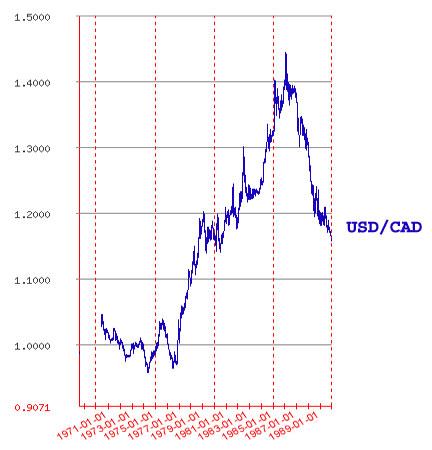
This chart shows the U.S. to Canadian dollar exchange rate, during the 1970’s and 1980’s. Notice how it bumped around near parity (1 for 1) during the 1970’s but then spiked dramatically during the 1980’s.
In the 1980’s, the exchange rate spiked dramatically and didn’t reverse; it just kept on moving. So now what do you do if you are a U.S. publisher selling into Canada? That exchange rate was just eating away into profit margins when revenues were exchanged back into U.S. currency, and the discrepancy was not reversing course back towards parity as it had done in the past. Something had to be done; something had to change. The solution? Prices had to be higher when comics were sold for Canadian dollars.
That’s How 75¢ Variants Came To Be
Now that you have the background, for the remainder of this post I will take you through the reasons this should be of interest to you as a collector, I will take you through an investigation of the window during which these variants occurred by examining the Uncanny X-Men and Amazing Spider-Man titles, and following that exercise I will highlight several key comics published during the price variant window that are particularly worthy of consideration for our collections (all of the price variants are arguably interesting but it is the major and minor keys that should be of primary focus). I’ll also show you CGC census data comparing the relative rarity of these to one of the most highly valued 35 cent variants of 1977, a data comparison which absolutely blows my mind relative to the market price premiums presently applied.
Let’s Walk Through The Publication Window…
At the time Marvel addressed this currency exchange rate problem, the cover price of a typical Marvel issue had been 60¢. Direct edition copies had been labeled with both 60¢ and 25 p (25 pence, for U.K. sales). So for direct edition copies (the non-returnable ones) it was just a matter of making the Canadian price different and adding that alternate price into the mix. Which is exactly what they did, at 75¢. You will notice that 75¢ is exactly 1.25x the U.S. price, which makes perfect sense referring back to that exchange rate chart.
To show this difference in what appeared on the cover, first look below at Uncanny X-Men #161, the issue published just before the introduction of the 75¢ price variant. As you can see, just one price of 60¢ covered both the U.S. and Canada, with an alternate 25 pence price listed for the U.K.:
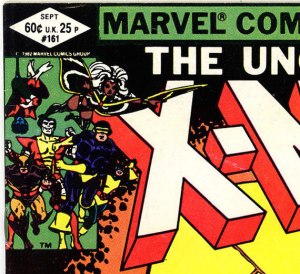
X-Men #161 direct edition.
The next issue, #162 was the first to be published with a 75¢ variant cover. The publication date was 10/1982. And now at this point, you will see just how these came to be… because the direct edition of #162 just has all the prices together (60¢ in large type, then the UK, then 75¢ CAN underneath). But…

At issue #162 the alternate price in Canada begins to appear, at 75 cents in small type at the bottom.
But instead of doing the same thing on newsstand copies, they printed distinct batches for each different price. Here is an example newsstand copy distributed in the U.S. (note the 60¢ cover price with no alternate price included):

X-Men #162 U.S. newsstand edition.
And now, an example copy of the same issue, but from the batch printed for Canadian newsstands (note the 75¢ cover price):

X-Men #162 Canadian newsstand edition.
For Canadians this must have felt like a huge price hike: one issue they’re paying 60¢ and the next they’re asked to pay 25% more? Our countries and cultures are so intertwined; kids growing up watching baseball in New York and Toronto all tuned into the same games whenever the Blue Jays played the Yankees, and both sets of kids grew up reading Amazing Spider-Man and other comic books. Imagine how the kids in Toronto and elsewhere in Canada felt when their comic book buying power suddenly fell by 25%!
Huge Population Disparity At Play Here
At this point I want to point out that the population of the United States in the 1980’s was almost ten times the population of Canada. One source I found listed the population of the U.S. at 235.8 million in 1984, and the population of Canada at 25.7 million. Meanwhile, for contrast, the population of California in 1984 was 25.84 million. The population of California alone is already larger than all of Canada.

The population of California was larger than Canada in the 1980’s when these variants were produced.
What this disparity should mean for the comparable rarity of the 75¢ cover price variants should be fairly obvious: by simple logic, drastically fewer of these were produced, to satisfy the demand of a drastically smaller market. A drastically smaller market that just got slammed with a 25% price hike. What’s also an important consideration is that the newsstand distribution channel was the only way to get the variants… because the comic shops across the U.S. and Canada all got the same direct edition copies with both prices listed. So we’re not just talking about a small market, we’re talking about the subset of that small market that was buying comics on newsstands instead of comic shops. And when it comes to condition of surviving copies, newsstand comics are notorious for being read to death, not to mention often discarded. Plus, to the staff of newsstands they were treated just like magazines (preserving condition for collectible value didn’t enter into their minds, for newsstands this was just another publication meant to be read, so they just tossed them right into those metal racks).
How Long Did These Variants Last? Were They Always Priced 75¢?
Clearly these 75¢ cover price variants are rare; a next logical question a collector may want to know is: during what time periods of publication can we find them? Let’s continue our look at these cover price variants within the Uncanny X-Men title. I showed pictures of issues #161 (immediately preceding the 75¢ variants) and #162 (the first 75¢ variant in the title) earlier. From there, how far out did these go before they stopped? Let’s check! Let’s look at issue #170 next, and then move up by 10’s until we hit the end of the publication window where these existed.

X-Men #170 direct edition.

X-Men #170 U.S. newsstand edition.

X-Men #170 Canadian newsstand edition.
So the 75 cent variant phenomenon continues to 170; let’s continue up by 10 and see if it is still there at 180, 190, and 200:
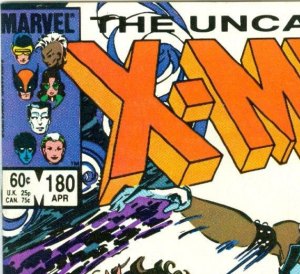
X-Men #180 direct edition.
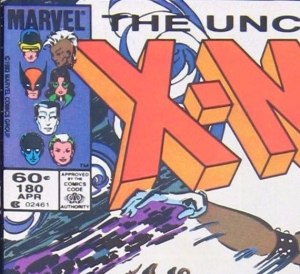
X-Men #180 U.S. newsstand edition.

X-Men #180 Canadian newsstand edition.

X-Men #190 direct edition.

X-Men #190 U.S. newsstand edition.

X-Men #190 Canadian newsstand edition.

Double-sized so the price was higher, but still two prices on the direct edition.
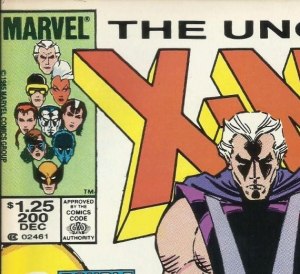
$1.25 cover price on U.S. newsstand edition.

$1.50 cover price on the Canadian newsstand edition.
As you can see, although issue #200 was double-sized and priced higher, the price variant phenomenon it is still going. But that’s about to change. Here is a direct edition copy of issue #210:

X-Men #210 direct edition.
As you can see, the cover price has now jumped to 75 cents in the U.S., and the Canadian price has jumped to 95 cents. So do we still have Canadian newsstand variants at this point? Let’s take a look:

See what they did there?
See what they did there? By issue #210 there is now one batch of newsstand copies printed for both the U.S. and Canada, with the two prices both listed on the cover (“95¢ CAN” in smaller type beneath “75¢ US”). So by merging the two previously distinct newsstand print runs into one, separate price variants have now ended. Was it the further price hike (to 95 cents) impacting demand on newsstands in Canada? Was it the steady decline of newsstand sales overall, with direct edition sales surging and taking over the market? Was it a bit of both? Probably. But at this point, one thing was clear: it no longer made sense for Marvel to print out a whole separate batch of newsstand copies for Canada. So they stopped, combining the print run and showing both prices. So from that point forward, U.S. and Canadian newsstands both got copies out of one large batch (just as they had been doing for the direct edition print run during that whole period). So if price variants are still going on at issue #200 but are over at issue #210, when was the last one? X-Men #208 is the last one:

X-Men #208 direct edition. 75 cent U.S. price at the top, 95 cent Canada price at the bottom.
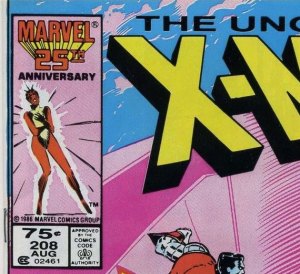
X-Men #208 U.S. newsstand edition, where the cover price had gone up to 75 cents by this point.

X-Men #208 Canadian newsstand edition (price had been increased to 95 cents at this point).
So as you can see, although we started with 75¢ variants published for newsstands in Canada, at the end there we had 95¢ variants (and I’m even aware of a $1.00 variant in the Secret Wars title which I’ll get to in a bit).
To recap the window of time during which these cover price variants occurred:
First price variant: Uncanny X-Men issue #162, published 10/1982
Last price variant: Uncanny X-Men issue #208, published 8/1986
And the 10/1982 starting point and 8/1986 ending point held for other titles as well, for example, Amazing Spider-Man. In 10/1982 they were up to issue #233. Here’s the issue immediately before that, just to double-check that it was still 60 cents and there weren’t earlier variants for ASM:

Issue #232 was the last 60 cent issue in Canada before the variants arrived.
It was. And now, here is issue #233:
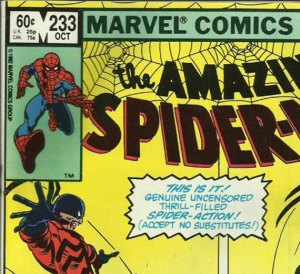
Amazing Spider-Man 233, direct edition. Alternate price of 75 cents for Canada was introduced. Publication date: 10/1982.

U.S. newsstand copy, priced at 60 cents.

Canadian newsstand copy, priced at 75 cents.
As you can see, the 75 cent cover price variants have begun, with the same 10/1982 start date as in the Uncanny X-Men title. And just like in the Uncanny X-Men title, the final Canadian price variant was published 8/1986 (and here too it was 95 cents).

The last cover price variant, at issue #279. By this point, the U.S. price was 75 cents and the price in Canada was 95 cents.

Here is a U.S. newsstand edition copy of ASM #279, priced at 75 cents.

And here is the last Canadian newsstand edition price variant, priced at 95 cents.
And then with issue #280 and on, Marvel switched to one newsstand batch to cover both countries, with both prices listed.

Direct edition copy of ASM #280.

Newsstand edition copy of ASM #280: at this issue, both the U.S. and Canadian prices are printed on all newsstand copies.
Our Window: 10/1982 to 8/1986 Is The Publication Date Range For These Price Variants
With this same pattern established across the two main titles, we can conclude that our window as collectors to look for these variants is any Marvel comic published 10/1982 through 8/1986 (a note here that this post is about Marvel but the same cover price variant phenomenon exists at other publishers such as Archie and D.C. which had different dates to their own price variant windows — D.C. Comics “Canadian Editions” lasted two years longer than Marvel’s… an example “key” outside of the end date of Marvel’s window is D.C.’s Legends #3 published in 1987 where a $1.00 price variant exists; this issue features the 1st New Suicide Squad appearance). Any key comic published within this cover price variant period should definitely be on our radar screens. Here are a few examples that stand out among the keys of this time period:
(1) Uncanny X-Men #201
In the Uncanny X-Men title, there are a number of very cool issues during our publication window, including a comic considered a “key” with X-Men #201 (first appearance of Cable as baby Nathan). Pictured below are the direct edition, U.S. newsstand edition, and Canadian newsstand edition for #201:

X-Men #201 direct edition (both 65 U.S. and Canada 75 cent cover prices listed).

X-Men #201 U.S. newsstand edition (65 cent cover price).

X-Men #201 Canadian newsstand edition (75 cent cover price).
(2) Amazing Spider-Man #238
In the Amazing Spider-Man title, the first appearance of Hobgoblin is in issue #238 which falls squarely within our price variant window:

Direct edition copy of ASM #238, listing both prices, 60 cents U.S. and 75 cents in Canada.

U.S. newsstand copy of ASM #238 with 60 cent cover price.

Canadian newsstand edition copy of ASM #238, with 75 cent cover price.
What also makes this issue doubly hard to find in high grade is the fact that it included free “Tattooz” inside and the book is considered incomplete (Qualified label at CGC) if these are absent. So to find a 75 cent variant with the Tattooz intact and the book in high grade condition, we need to be looking for the copies that were carefully plucked from the newsstands and stored away by a collector (a reader was likely to have ripped the Tattooz out and used them). Finding a complete newsstand copy with Tattooz intact is not such an easy feat… And the rarity shows up in the CGC census numbers, where as of this writing a grand total of 3,666 copies have been turned in by collectors to be graded. And of those, only 33 copies are the 75 cent Canadian Edition variant (and includes the ones that are in the Qualified column). That’s a little under 1%, essentially a “1-in-100” variant based on the census numbers, which are shown below from a screen-capture taken at the time of this writing:

ASM #238 census comparison: out of 3,666 total copies graded, only 33 show up as the Canadian Edition variant (with the 75 cent cover price).
Given this rarity, is the current market price premium warranted? I’d argue heck yes, and in fact, I think the current prices are an absolute bargain! Here’s what the popular online price guide ComicsPriceGuide.com shows for the comparable values:
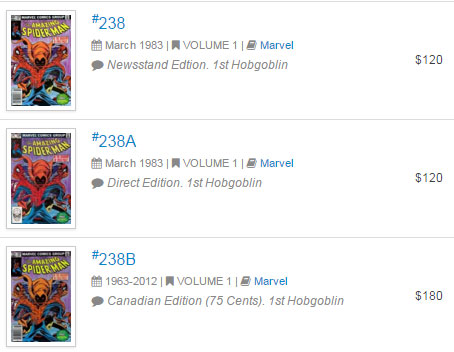
ComicsPriceGuide.com ascribes a $120 NM value to both the Direct Edition and U.S. newsstand edition, while giving an $180 value to the Canadian Edition (a 50% premium in price for the price variant).
As you can see above, this price guide values the 75 cent price variant at a 50% premium to regularly priced copies. At the time of this comic’s publication, the relative quantity of U.S. newsstand distribution copies versus direct edition copies may play a part in the price guide’s determination of equal value for the direct edition and U.S. newsstand edition. Although newsstand copies have a much lower survivorship rate than direct edition copies, it was not until the 1985/1986 time-frame that direct sales had grown to an even 50/50 split of the total distribution.
I also want to note that Hobgoblin later appeared in ASM #244 and interestingly for this issue the same price guide only applies a 25% premium for the price variant:

Hobgoblin appeared in issue #244, but here instead of a 50% premium for the price variant, the price guide only gives a 25% premium.
The smaller percentage premium for #244 versus #238 may have to do in part with the destruction rate of the #238 Tattooz in newsstand copies versus direct edition copies, but it also makes sense that the more sought after the key issue in question, the more awareness there will be out there among collectors about a more rare variant version. And ASM #238 is simply more sought after than ASM #244.
And to give an example of an even more sought after issue than ASM #238, consider Iron Fist #14. The 35 cent variants of Iron Fist #14 (also see the 35 cent variants of Star Wars #1-4 for another example) from 1977 when Marvel tested a price increase with a small batch of copies, are given a drastically higher value versus their regularly priced counterparts. For example — that same price guide gives a value of $5,000 for a NM 35 cent variant of Iron Fist #14 as compared to just $300 for a regular price copy of the same issue.
That’s about 17x the value ascribed to the variant over the regular priced copy. Meanwhile, for reference, on the CGC census there are 2,908 total graded copies of Iron Fist #14 and 43 of them are the price variant. That works out to 1.5% of the total. So a 1.5% rarity price variant translates to 17x the price, for Iron Fist #14.
(3) Amazing Spider-Man #252
First appearance of the black costume, and an Amazing Fantasy #15 cover swipe!
[ 12/13/2016 update: Also see my separate post specifically focused on this issue: Amazing Spider-Man #252 75¢ “Canadian Edition” Variant: CGC Census Rarity Over Time ]
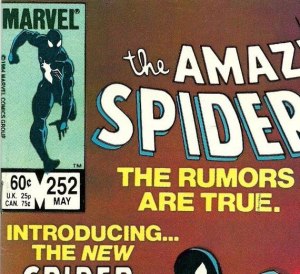
Direct edition copy of ASM #252.

U.S. newsstand edition copy of ASM #252 with 60 cent cover price.

ASM #252 Canadian newsstand copy, with 75 cent cover price.
This issue has an even higher count of total census copies at 6,906 as of this writing, with 118 of those or 1.7% being the 75 cent cover price variant.
(4) Wolverine Limited Series #2, #3, and #4
With issue #1 of the Wolverine Limited Series, we just miss the price variant window, with issue #1 published 9/1982. But issue #2, published 10/1982 has the 75 cent variant, as do issues #3 and #4.

Published 9/1982, issue #1 of Wolverine Limited Series came out a month before the price variants started.

But issue #2 has them! Here is a direct edition copy, note that it lists both the 60 cent U.S. price, and 75 cents Canada at the bottom.

U.S. newsstand copy of Wolverine #2, priced at 60 cents.
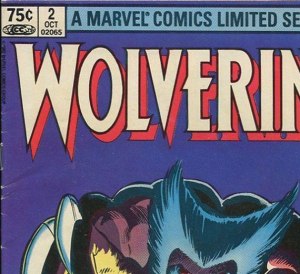
Canadian newsstand edition copy of Wolverine Limited Series #2, with 75 cent cover price.
I find these especially neat because of Wolverine’s debut as “The World’s First And Greatest Canadian Super Hero” which ties in so nicely with Canadian newsstands as the origin of the 75¢ price variants.
(5) New Mutants #1
Price variants for any comics outside of the “major” titles like X-Men and Spider-Man, are noticeably harder to find out there, and New Mutants #1 as an example of that phenomenon seems to be very scarce. There are no price variant copies on the CGC census at the time I wrote this blog post, not a single one is listed, despite the known treatment by CGC for other 75 cent price variants consistently being given the “Canadian Edition” variant treatment! But for New Mutants #1, not one single copy appears on the census!
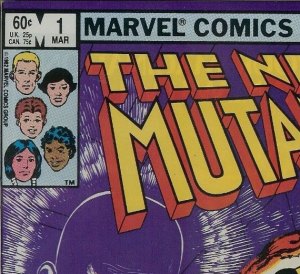
Direct edition copy of New Mutants #1. 60c price on top, “C.A.N. 75c” listed underneath.

U.S. newsstand copy with 60¢ cover price.
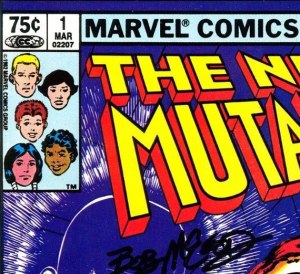
Canadian newsstand copy with 75¢ cover price. When looking for a picture of one for this blog post, I searched eBay and could only find this one single copy out there.
Note that New Mutants #1 is credited by CGC as the second appearance of the New Mutants. For the 1st appearance of the New Mutants, there is a Canadian cover price variant out there to collect too [ see this separate post: Marvel Graphic Novel #4 — $5.95 Cover Price Variant (1st New Mutants Appearance) ].
(6) X-Factor #6
Published in July of 1986, X-Factor #6 contains the first full appearance of Apocalypse, and is an example where the cover price variant was 95 cents (with regularly priced issues being 75 cents).
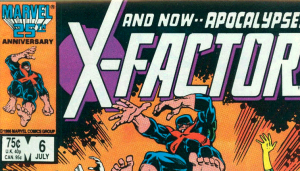
A direct edition copy of X-Factor #6. The large type US cover price was 75 cents (CAN. 95 cents at the bottom).
The newsstand copies sent to Canada carried a 95 cent cover price:
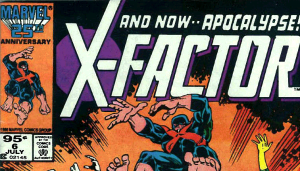
A 95 cent cover price variant copy of X-Factor #6.
For X-Factor #6 I want to walk through a print run analysis exercise — because 1986 is one of the years where insiders have specifically discussed the state of the two different comic book distribution channels and even given estimates for the distribution statistics at Marvel. Specifically, Jim Shooter has cited 1986 as the time-frame where he was battling the “brass” at Marvel to try and save the ailing newsstand distribution channel; and another industry insider, Chuck Rozanski, has pegged 1985/1986 as the time-frame when direct edition sales would overtake newsstand sales. (Here are some quotes from Shooter and Rozanski about what was going on in this time-frame).
And because X-Factor #6 was published right smack in the middle of the year 1986, this lets us very reasonably make a 50/50 split between direct edition and newsstand when estimating. We can cut the Canadian market right in half between the regular direct edition copies and the rare 95 cent price variants… making for some extremely easy ballpark math when analyzing the number of copies that were likely to have been our rare price variants (we don’t even need a calculator!):
Step 1: First we need to get an idea of the total sales of the comic as a starting point — a search turned up a print run of 340,000 copies for X-Factor #6 (according to this source).
Step 2: Ballpark the Canadian market size — based on the 1986 population statistics with Canada at 26.2 million people and the U.S. at 240.1 million people, that puts Canada at 9.8% of the combined market for comic books by population (for the entire price variant window this 9.8% figure holds by the way). Let’s round that up to 10% for easy math because that lets us simply move a decimal place. In other words, in this step we chop a zero off of the total from step 1. That means our ballpark math is 34,000 total copies sent to Canada (which would be inclusive of both direct and newsstand).
Step 3: Out of those 34,000 ballpark copies sent to Canada, we can now split those up by direct/newsstand. Based on the discussions by industry insiders, if we use the 1986 statistic being 50/50 direct/newsstand, that means our math is extremely easy: just chop that 34,000 in half… 17,000.
Conclusion: by these estimates, there may be only 17,000 copies of X-Factor #6 out there with the 95 cent variant cover price. For a key first appearance, this is already a very nice low number, but it is only the starting point estimate at time of distribution. Where did the typical high newsstand destruction rate take the numbers from there? As of 2016, the CGC census shows a mere 15 copies out of 3,438 total graded copies… putting the cover price variant at census rarity of 4 tenths of one percent, suggesting that the percentage of “CGC-worthy” survivor copies out there may be very low indeed.
“Rule of Thumb”
This estimation technique comes in really handy as a very quick and easy “rule of thumb” to estimate a ballpark count for the cover price variant numbers for any of these comics published closer to 1986 — first take the total across the issue number (inclusive of variants) as the starting point, then move the decimal place one to the left (or chop off the last zero, same thing), and then halve the resulting value. And of course, this is all estimation, but estimates can be useful.
(7) Secret Wars #8
Amid the chaos, there comes, a costume–! What is especially interesting about the price variant for this key, is that in the example before this one of X-Factor #6 — and for all the examples I showed earlier exploring the X-Men and Amazing Spider-Man titles — when they got to 75 cents U.S., the Canadian price variant became 95 cents. But for Secret Wars #8, Canadians were charged a full $1.00 [related: DC is believed to have test-marketed a nickel price increase with their $1.00 variants]. And being outside of a major title like Spider-Man or X-Men, I found that the variant for this one was also very difficult to locate when I went looking for a picture.

Secret Wars #8, interestingly, shows a 75 cent price for the U.S., but instead of 95 cents for Canada this one priced Canada at a full $1.00.

U.S. newsstand copies of Secret Wars #8 were priced at 75 cents.

But Canadians had to pony up a full $1.00, for the price variant sent to newsstands in Canada.
And if you were impressed by the under 1% CGC census rarity of the ASM #238 price variant, and the 0.4% CGC census rarity of X-Factor #6, wait until you see the comparable number for Secret Wars #8. Out of a total 7,919 copies sent in to CGC, there are a grand total of 25 copies of the $1.00 price variant Canadian Edition listed at CGC, or 0.32% of the total.
Remember too, that the 1.5%-rarity Iron Fist #14 copies are valued 17x higher than their regularly priced counterparts… and the astronomically-valued Star Wars #1 35 cent variant shows up on the CGC census with 3.2% rarity. So get ready for the bargain of the century because ComicsPriceGuide.com values the $1.00 Secret Wars #8 variants at a premium of… wait for it… equal to regular copies.
That’s right, no premium, not even the 25% premium given to ASM #244. Huh? And seeing this leads me to believe that maybe, just maybe, collectors don’t actually know very much about these variants. Maybe the price guide people don’t know very much about these either? Because no premium for this unbelievably rare price variant is ludicrous! Now that you’ve learned all this information about these price variants, wouldn’t you agree??
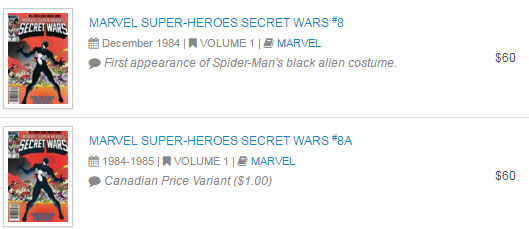
And the value of the price variant is…. equal?…. huh?
Thanks for reading, and Happy Collecting! Canadian newsstand comics are one of what I now know to be several “Special Situations” where CGC “breaks out” newsstand copies as distinct variants. Learn more about the other special situation categories which include “Newsstand Variant” comics (“incorrect” UPC codes), “Newsstand Edition” variants (manufacturing differences), and $3.99 Newsstand Editions (which carry a $1 higher cover price).
[5/6/2019 update: CGC announced that as of May 6, 2019, they will label as “Canadian Price Variant” going forward 🙂]

Hi- great articles-
-just wondered if you have any 80s Marvel Newsstand editions or Canadian editions in NM/MT grade for sale-
-also, I have some information regarding Tattooz in Canadian editions, that would clarify some things-
LikeLike
Smart of you to want NM/MT grade copies as those would be the most difficult (I count myself as a buyer, not a seller, of such rarities — sorry!). NM/MT newsstand survivor copies are almost unimaginable but they’re out there here and there… I am aware of a large modern newsstand collection currently being liquidated where a doctor had a connection with the owner a drugstore and was able to acquire his copies before they “hit” the stands and could be damaged (that collection is late modern though, not 1980’s, but I mention it as an example because similar collectors could have been out there in the 1980’s with connections to be able to select their copies before they hit the stands). I can also picture a NM/MT copy hitting the stands but surviving “sandwiched” between two outer copies and protected from damage. Anything NM and above is pretty amazing to find. Regarding additional Tattooz information, please share!
LikeLike
Cool-
I’m looking for certain newsstand titles/issues from the 80’s- is there anything I can buy from the collection that the doctor is liquidating?
Most of the issues in looking for are non-key.
I do have some 80’s Canadian editions in high grade- one of which is FF 252- that’s an issue that has Tatttooz in US. edition. However, after doing research with Canadian comic experts, it was determined that the Canadian edition wasn’t manufactured with Tattooz. Overstreet confirmed that recently. I’m not sure about the other issues that month (like ASM 238 you mentioned), but I imagine that the Canadian editions weren’t manufactured with Tattooz either.
LikeLike
Although it doesn’t go back to the 80’s, the “Doc Collection” does have a huge selection of modern newsstand comics (including some modern price variants that carry a $1.00 higher cover price than their direct edition counterparts) and it is being liquidated by a seller that goes by “hirivercomics” on eBay, they seem to auction off a new batch from that collection every month or so, with each copy listed individually (as opposed to in lots) and each auction starting at $1. He advertises them all NM- but I’ve won quite a few and can tell you first hand that there are some NM/MT copies in the mix. While they last you would be able to find them at the following URL (I don’t see any at this particular moment from a search of his listings on the word “newsstand” but that’s probably because a batch just ended): http://www.ebay.com/sch/hirivercomics/m.html
Thanks for sharing that information about the Tattooz in Fantastic Four #252, that’s very interesting! For ASM #238 I know for sure that the Canadian editions have tattooz inside because I’ve personally purchased one and checked it for the tattooz; also, there are enough CGC graded copies that you can find a Canadian Edition and the CGC label does say “Tattooz inside” (example: http://www.ebay.com/itm/282014241077). Curious about the label on FF 252 copies I searched, but I couldn’t find a CGC graded Canadian Edition of FF 252 to check the label. But I then looked up FF 252 on the CGC census and I see that they have only graded *one* copy of the Canadian Edition of that issue (no wonder I couldn’t find one!). Does the one CGC copy happen to belong to you, that you could check whether CGC noticed this phenomenon and described it on the label?
LikeLike
Thanks-
that’s interesting that you Found Tattooz in ASM 238- I thought it wouldn’t have them.
I spoke with a Canadian comic expert who was one of the people responsible for Overstreet’s addendum to the Canadian FF 252, and I notified CGC of this about a year ago. So if you find a copy, their label will state there’s no Tattoz included in Canadian
edition (based upon Overstreet Guide).
LikeLike
Hi, thank you for sharing. I’m a newbie to collecting comics and your site has been a fantastic resource. Please write more often! I’ll be checking in periodically for updates.
LikeLike
These issues are taking off. Even in Canada their hard to find. Important note is, that these Canadian edition variants were sold in the US. How do it know? Because I purchased Canadian variants in Lyndon Washington, sumas Washington, Bellingham Washington. I also bought US editions sold in Canada, like at Big Bills Books in Langley BC, or Pipe and Pouch tobacco shop in Langley….. American and Canadian edition were in FACT sold on both sides of the border…..Nice Article and very Accurate
If I was a newby at this hobby I would start buying up these issues, only if increasing the value to your collection is the goal.. Happy comic collecting 🙂
LikeLike
Thanks so much for the comment, and especially the first hand insight on cross-border availability on the newsstands… I have won more than one 75 cent price variant at auction from sellers based in Washington (also Maine) which made me suspect some of these variants might have been sold in US states that touch Canada, especially early on in the price variant phenomenon. But that was always just a suspicion I had and I never knew if those copies I won had simply migrated south after the initial collector purchased them.
Your comment with first hand experience proves that some cover price variants must have “spilled” into border states, and regularly priced copies also “spilled” up into Canada. I guess that means some US buyers overpaid by 25% and some Canadians got a nice deal (although now I guess they might wish they had paid the higher price for the more rare version)! It makes sense to me when I picture how Marvel’s change must have “strained” the distribution logistics and required some adjustment. Everyone had been used to one print run of newsstand copies to cover both countries and then suddenly this change was forced upon them… Under those circumstances I can easily picture some 75 cent copies ending up on US newsstands close to the border.
LikeLike
Again, thank you for the great information. It has been tremendously helpful. I have a question as it relates to Canadian Variant comics graded in CGC versus CBCS. I have purchased a few New Mutant comics of the Canadian Variant in CBCS 9.8 lately but I was curious if it would be discounted by the market because it is CBCS certified and not CGC. Any thoughts or insight into this?
Thank you again!
PK
LikeLike
I think whether with these price variants or with any comic right now, this is a more broad question of general CBCS vs. CGC value… Which is a good question, and the answer may very well evolve with the passage of time. At this particular moment in time, I routinely observe auctions where CGC graded copies are bid to a premium versus CBCS copies of the same comics.
I recently witnessed an example of two of the exact same comic auctioned off, by the same seller, with the same shipping quote, and the same end date on the two auctions. One was CBCS 9.8 and the other was CGC 9.6… Again, same exact comic and all other variables also the same, the only variables that were different were the grading company and the grades. If you can believe it, the CGC copy in 9.6 actually auctioned off for basically the same price as the CBCS copy in 9.8! I’ve seen similar price disparity between CGC and PGX copies (i.e. CGC comics routinely get a premium to PGX graded ones too).
I think part of the answer is that CGC has simply been around for so long, and has been the market leader all this time. CBCS is still new, and while most collectors are probably familiar with them by now I have to wonder how many collectors are still only searching “whatever-they-are-looking-for CGC” as the search term, out of years of habit, or out of preference… And if that search result satisfies what they’re seeking, maybe they don’t bother to search a second time with CBCS in place of CGC for the keyword. Fewer bidders reaching an item in this way could contribute to lower prices.
I actually often notice listings that say “CBCS – like CGC” or “CBCS (not CGC)” or similar variations on that theme in their listing title… Sellers may be doing that to get “CGC” in there as a keyword, to help people actually find their listing. Which speaks to my point that people may not be searching as frequently on the CBCS keyword, versus CGC, and these sellers have figured out they can get those CGC keyword searchers to find them in this way.
So this all may play a role in the current market discount. And this is just one snapshot in time, CBCS is still very young, and the situation may very well evolve over time in unpredictable ways. When these variants were originally produced, who could have predicted the future existence of CGC or CBCS? What will things look like 20 years from now? Who knows what the future holds. The bottom line is that you own the comic *inside* the slab, that’s the important thing, it is the comic itself that is the rare and collectible item, whether it is a CGC slab or a CBCS slab that is now preserving its condition. And don’t forget, all of these slabs are designed to be able to be cracked open, should you ever want to take the comic out (to get it signed for example, or graded by a different company). So down the line if/when you are looking to sell your collection you find that one, the other, or a third still-unknown-future-option is the one achieving premium prices, worst case your theoretical value is the highest premium price out there minus the cost to “switch” over to the grading company “on top” at that point.
LikeLike
Thanks for your thoughts! I’m curious how big the pricing premium is between CGC and CGCS and if it’s purely first mover reputation that is driving that differential. Or, if CGC graded and slabbed comics are graded with greater scrutiny and critique than a CBCS comic that is driving the pricing differential of two equally graded comics. I imagine grading comics is very subjective and very difficult to be consistent from one comic to the next. In theory, if grading criteria is the same one should be able to purchase a CBCS graded comic and crossover to a CGC graded comic and receive the same grade by simply by paying the grading and slabbing fees. Which leads me to wonder it this present a market arbitrage opportunity to buy highly graded CBCS comics at a discount and crossover to CGC.
All my curiosity with grading aside, I believe you said it best when you indicated that “the bottom line is that you own the comic inside the slab” … and that “it is the comic that is the rare and collectible item.”
LikeLike
I’m new to comic book collecting, but I know it is a mature hobby and industry, so I’m curious as to why the rarity of the newsstand and Canadian variants haven’t been fully appreciated by the markets yet? If the rarity discrepency for certain print runs are 10% of total with most likely just a fraction of that 10% in NM/MT condition shouldn’t the premium for these variant books in high grade reflect a pricing premium that is equivalent to the rarity of the book… especially for some of the more popular series like X-men or Spider-Man?
It’s interesting that the market very selectively recognizes the rarity of the Star Wars 1 – 35c and Iron Fist 14 – 35c variant as reflected in the price for these comics but not for example Spiderm 238 or Wolverine limited series 1 newsstand, which are very popular characters. Perhaps, market ignorance is our benefit?
I understand that rarity doesn’t always translate into valuable because something is only valuable if it is highly demanded with limited supply. And, just because something is in large supply (e.g. New Mutants 98) doesn’t mean it can’t be valuable — although I would never invest in such a common comic like NM98 at current prices.
LikeLike
Insightful observations, PK!
On possible arbitrage: well before CBCS came into existence someone gave me an interesting tip that they’d been winning PGX 9.6’s at great prices at auction, then cracking them out and sending them to CGC, and quite often got back CGC 9.8’s. I have tried this myself a couple of times and found it to be hit and miss. At a certain price discount — one that covers the cost to switch plus enough buffer to also cover the possibility of downgrade — it seems like it would be hard to go wrong. The supply of such opportunities out there is another question. With CBCS, because they give access to the grading notes online, you can get a really good idea in advance about the flaws contributing to the grade they gave a particular book, before jumping into any given opportunity.
On the current market under-appreciation of the rarity of our price variants: I think the facts about these are crystal clear, so that leaves only two possible explanations for why they are not given the type of premium one might expect: A) People don’t know; or B) People don’t care. I haven’t met the collector yet where I’ve explained the rarity facts to them, and then, even understanding those facts, they decided they didn’t care. Everybody seems to care, once they know the facts. So I must conclude that it is the former explanation… that the majority simply just don’t know. Contributing to this lack of awareness could be a number of things. For one, I imagine that these variants have been fairly slow to move South over time. Although some of them were purchased in the US to begin with in border states (as another commenter pointed out from their first hand experience), the bulk of them reached the intended market on the other side of the border, and from there I have to imagine that collectors are simply more inclined to look locally for any particular comic they are seeking (I imagine this was especially true before the Internet expanded the trading market for comic books — so the Internet era has probably accelerated the migration of these variants throughout North America). By contrast those 30/35 cent test market variants would have dispersed from their original origins pretty rapidly. So being slow to move South, and being that there are simply so few of them around for people to notice, the principle of “out of sight, out of mind” could very well play a role… many US collectors may never have actually noticed they exist.
And then I will echo something another commenter said on another post of mine when they noted the following: “Just like Marvel’s .30-.35 cent variants it only took Overstreet 25 years to figure out there was a difference!!” It took Overstreet quite awhile to make mention of those test market variants. And notice in the below screenshot of a recent year Overstreet on the Amazing Spider-Man page where 75 cent variants begin to exist, that while they have special entries for 30 and 35 cent variants (see *** spots), when they get to the point in time where 75 cent variants were introduced, it is mums the word… no mention.
LikeLike
Fascinating thought! Solarcollector, thank you very much for being so generous with your thoughts and I’ve very much appreciated the great exchange of thoughts. I’ve learned so much from you already and your articles have formed the basis for my investment thesis and strategy in acquiring rare comic books — to focus on key Bronze Age Canadian Edition and Newsstand variant comics and Direct Edition comics for 1982 and prior.
Since coming upon your sight I’ve been lucky to identify and acquire a couple of the Canadian variant comics in CGC or CBCS 9.8 (New Mutants 1 and Spider-Man 252) that you’ve highlighted but I still have a long way to go. As you indicated, when a critical mass of collectors/investors begin to understand the facts behind the rarity of the Candian price and newsstand variant comics the price will begin to reflect the true rarity of the comic. After all, what’s rare is valuable and what’s valuable is desired. Until then, I’ll keep hunting for those Canadian variant comics! But, hopefully it doesn’t take another 25 years for the market to understand these variants’ true rarity!
LikeLike
Hi PK, following up on our conversation from last month, on the topic of why Canadian price variant comics have not seen the market values one might expect given their rarity, I have some new information. In thinking about 35 cent variants as a peer group, I did some research to try and investigate whether there was a “catalyst” that caused that “class” of cover price variants to get noticed by collectors.
I only got back into the hobby of comic collecting in 2003, but it turns out that “while I was gone” there was a 1998 article that is widely credited by collectors as the moment in time when those “peer group” price variants “took off” as a category of collectibles. The article in question was published in issue #55 of Comic Book Marketplace magazine. I hunted down a hard copy of this magazine (too early for the content to be online it seems, as I could not find it).
As it turns out the article in that issue is actually “part II”… It is entitled “The 30¢ Price Puzzle: Making sense of Bronze Age Marvel Price Variants.” The author is Jon McClure. Part I is said to be in issue #51 of the same magazine (I have yet to acquire a hard copy of that one). It is an interesting read on a few levels. For one, it has clearly gotten a whole lot easier for collectors to research comics since 1998! The article mentions how over the years, in different Overstreet price guides, they started mentioning 30 or 35 cent variant copies of one particular specific issue or another (presumably as they were discovered to exist, or as market values warranted Overstreet “breaking them out”). The article also highlights a long list of comics that “might” have price variants and then confirms ones that were actually verified. (That would have been so much easier to research in this day and age, by looking through eBay listings in order to verify variant existence!!)
[Side note to highlight the state of the comic collecting world in 1998: the page to the right of the article is an advertisement page, and the advertiser who bought the ad space lists a phone number — and under the phone number the ad says “Sorry, no answering machine!” Isn’t that a funny sign of the times? I’m trying to remember what speed dial-up modem I had back in 1998? Anyway, we certainly are in a much different era, one where information is far easier to research and also easier to share with other collectors!]
A few notable passages from the article that I want to quote:
“Of the eight 35¢ variants and five 30¢ variants noted in Overstreet #27, four of them are Star Wars #1-4, three are X-Men #98-99, and #106, and the eighth is Iron Fist #15. That’s right, two out of three are popular, high visibility, high demand comics. Only four others have been noticed and referred to by Overstreet in the last 20 years!”
What a strong parallel to the Canadian price variants, of having been overlooked, wouldn’t you agree?! Interesting too that X-Men issue #100 wasn’t mentioned back then, that is one of the more highly valued 30 cent variants today, and wasn’t even shown in the guide back then (unless the article has a typo and 106 is meant to be 100). Another passage that shows a strong parallel to our variants:
“It makes sense that variant comics have remained virtually unknown until now, when you consider that they are nearly impossible to notice or detect unless you know what to look for.”
And here’s yet another quote that I find particularly interesting and I’m sure you will too:
“And we haven’t yet investigated the 75¢ price variants that are known to exist (see the Thor #338 variant listed in Overstreet). There’s obviously much more of the price variant puzzle left for collectors to explore.”
So at the time this article was written — the article widely credited by collectors as the catalyst for widespread awareness of 30/35¢ price variants — even the author of the article himself hadn’t begun to investigate just what these 75¢ variants even were, knowing only that one existed and was mentioned in Overstreet. That was actually news to me: I hadn’t known *any* 75 cent variants were listed in Overstreet (I had shared an ASM page previously for example, from a recent Overstreet, which makes no mention of the 75 cent variants in that title at the point in time when they begin to exist).
The remark here by McClure about “75 cent variants” (as his chosen phrase) also helps explain why I’ve seen that exact term used to describe this “class” of Canadian price variants despite the fact that the variant price is different depending on the “regular” price of the given comic (X-Factor #6 at 95¢ and Secret Wars #8 at $1.00 being two examples where the variant price is not in fact 75¢). This also reflects how little must have been known about these at the time, for a more broadly encompassing term to cover those higher price examples would have been more appropriate.
And then one final passage to show just where the state of the collector’s market for 30/35¢ variants was at the time of that article — that time being two *decades* after original publication of those variants (talk about plenty of time for the hobby to “mature”!!):
“Although some may not agree, I personally feel variant comics are highly collectible. I also believe that the majority of variants will prove hard-to-find. Perhaps they are scarce and seemingly undervalued because few have been paying attention to them and even fewer have documented them. As the emphasis on Bronze Age continues to grow, I feel certain all that will change.”
And PK, during the short time between our last discussion on this topic and today, things have already started to change, both with newsstand comics generally, and Canadian price variants specifically… One case in point: I noticed in my WordPress stats page today that a visitor found my blog from a Google search on the phrase “why are newsstand comics worth more?” People are clearly starting to notice newsstand values pulling away from direct edition values in certain cases and wanting to know the answer. [ I went ahead and put up a post today to specifically answer their question: https://rarecomics.wordpress.com/why-are-newsstand-comics-worth-more/ ]
In researching prices for that post, I checked some recent market prices for some of the mega-key Canadian price variants. These don’t come up for sale often so I wasn’t expecting many examples, but I found that a 9.8 copy of Secret Wars #8 with $1.00 cover price recently sold for $525. (Direct edition 9.8 recent sale comps being under $200 by contrast). As examples for other rare newsstand comics, Spawn #1 and #9 newsstand values have also recently “pulled apart” from their direct edition counterparts, with 9.8 newsstand copies selling for upwards of $275, versus regular direct edition copies in 9.8 going for around the $70 mark.
To remain a relevant price guide and serve its useful purpose, Overstreet will pretty much have to react to these market prices once they feel they are not a temporary aberration, by breaking these variants out separately in the guide. If there are two discernible versions and one of the two is going for a drastic premium in the market, it is their responsibility to inform collectors of the values accordingly. Over time if Overstreet does this, collectors will then notice the second listing in the guide when they are looking up the values for those issue numbers. As more collectors notice a variant exists, they will want to research to find out just what the difference is… And once they learn the facts, they will want to own copies of these variants. That spells more demand… You can easily envision a positive feedback loop here… a “snowball effect”… where just as the 35 cent variants “took off” prompted by the catalyst of the 1998 article, our 75 cent variants can be similarly discovered as collectors share information about them.
Another side note: In our last exchange you addressed me by my WordPress “handle” because my real name was not previously listed on my blog. Because of my job, it might have been a problem for my employer if I broke anonymity and I didn’t have a reason to raise the matter and ask permission… However, something changed recently that prompted me to request permission from my employer, and it was granted today. So that is why my name is now in the byline at the top, and why I will sign this comment with:
Best,
– Ben
LikeLike
Realizing I’m coming very late to this party, but…
I have a full set of 30 cent variants (my set was the first).
I have a near complete set of 35s – I do not have the Scooby and some others.
I have a a complete set of 75 cent variant Marvels.
I do not as yet have a complete set of 95 cent variant Marvels.
Every Marvel title published during the period that exists has a corresponding variant price. The fun ones are the weirdly priced books, especially DCs, where there are $1.60 cover prices on some things.
By FAR the hardest mainstream 95 center to find is Thor 370, the last issue. They don’t go for a lot, but they’re impossible to find.
LikeLike
Thanks for reading and commenting! Mighty impressive that you have those full sets, sounds like you are a big fan of cover price variants! Am I correct in interpreting from your comment that the later 95 cent variants were more challenging to obtain than the earlier 75 cent variants? (One of my conclusions about the Marvel variant window of the 1980’s has been that because they were newsstand-only, and because industry insiders have discussed how direct edition sales grew to take over the market and surpass newsstand sales sometime around 1985/1986, that the later we go in the variant window — all else equal — the lower the percentage of price variants we should see, correlating to the decline in newsstand sales.)
I’ll have to see if I can find that Thor #370 with 95 cent price! I’ve had a tough time locating some of the later X-Men’s priced at 95 cents myself… Crisis on Infinite Earths variants were really tough — starting at 95 cents and issue #7 having that $1.60 variant price you mentioned. I still haven’t landed the Machine Man mini-series with $1.00 cover prices. Recently got lucky with a NM Secret Wars #8 with $1.00 cover price… I continue to be amazed how it is possible to acquire these variants for “regular prices” — so many sellers simply don’t know what they have!
Best,
– Ben
P.s. As of recently, CGC has decided to recognize $3.99 newsstand editions (priced $1 higher than their regular $2.99 edition counter-parts), as distinct variants broken out on census. I imagine collecting a complete set of those would be next to impossible! https://rarecomics.wordpress.com/2016/08/31/newsstand-variants-3-99-newsstand-editions-and-the-doc-collection/
LikeLike
Your always welcome, and always good to read your comments. Thx 🙂
LikeLike
Hello to everyone who has commented on this post, I’m leaving this follow-up comment to share a thought with you: that I think we have a potential upcoming catalyst for an incremental step-up in collector awareness of Canadian price variant comics as a category.
Remember when Angela entered the Marvel universe as Thor’s sister, and there was a surge of collector interest in owning her first appearance (Spawn #9)? That sudden surge of new submission interest introduced many collectors to the “Newsstand Edition” variant of issue #9 which they may not have already known existed (because only a small percentage of submissions were “broken out” that way; a very large number of total submissions was needed to produce a visible number of CGC-graded variants).
Spawn #9 newsstand editions then became a “gateway” into other Spawn newsstand comics — I think there is strong evidence of this in the timing of increased market prices for newsstand copies of Spawn #1 (which had previously been next to “invisible” due to its small number of copies and not even being a CGC-recognized census variant, but suddenly, as the Spawn #9 interest came poring in, we then saw the newsstand rarity factor for Spawn #1 “get noticed” too).
In a similar way, I think we have an upcoming catalyst for collectors to inadvertently walk through the gateway to Canadian price variant comics, when the New Mutants movie prompts them to want to own Marvel Graphic Novel #4, the key first appearance.
I’ll explain my thinking further.
One “problem” we have with our newsstand-exclusive price variant comics is that the percentage of them out there is so small as to be nearly invisible… The principle of “out of sight, out of mind” definitely applies. For example, I have submitted a copy of New Mutants #1 Canadian Edition in the “race” to be the first to submit one to CGC… It looks like someone other than me has apparently won that race, as there is now 1 copy on census of the variant. Who out there is going to notice, with numbers like this? With 1, soon to be 2?
Few, if any, will naturally notice. I suggest that we need the marketplace to be sufficiently saturated with enough CGC-graded variant copies that there’s always a selection of them online on eBay any time someone goes looking for a given issue, for awareness to really build. Two variant CGC copies in existence of New Mutants #1 won’t even come close to the necessary visibility numbers.
Enter Marvel Graphic Novel #4. Not a comic book… no newsstand exclusivity variable… It is a graphic novel, and distributed as such. The buyers were not “sorted” by the two distribution channels, into a “mostly-collector-group” (direct edition), versus a “mostly-reader-group” (newsstand). So there’s no newsstand-destruction-rate or other buyer-behavior variable. Instead, with this graphic novel, the buying groups should be similar between variants and regularly priced copies. And instead of being distributed only to the “newsstand fraction” of Canada, they would have reached that full market.
That full Canadian market, by 1982 population, suggests that 9.8% of copies on census for Marvel Graphic Novel #4 would be the variant (Canada being 9.8% of the market size by population, the USA the other 90.2%). There are presently a grand total of 431 first print copies of Marvel Graphic Novel #4 that have been turned in to CGC for grading, and show up on census today. Based on the logic I’ve argued above, our prediction would be that about 9.8% of those copies would be the $5.95 cover price variant, or 42 copies, versus 389 “regular” copies. This prediction ends up having almost uncanny precision: the true number is 41 variants on census as I type.
And here’s the thing: if the number of copies submitted to CGC of this key first appearance surges upward in the future, driven by New Mutants interest, we may very well end up with a sufficiently large pool of these variants out there in the marketplace that they get noticed.
Anyone who notices them will not see “Canadian Edition” as the variant name… As a graphic novel without the newsstand-variable, CGC merely calls these variants “$5.95 Cover Price”… People who collect them (or think about collecting them) will be interested to learn what they are. I’ve put up a new post aimed at these inquisitive collectors, and I think by the end of reading it they’ll realize that by collecting the $5.95 Cover Price variant of Marvel Graphic Novel #4, they have just inadvertently stepped through an open door into a whole world of 1980’s cover price variants they never knew existed.
To the degree, if any, that this scenario I’ve outlined happens, we should then see a corresponding incremental step-up in collector awareness of this “category” of variants.
Here’s my Marvel Graphic Novel #4 post: https://rarecomics.wordpress.com/2016/12/14/marvel-graphic-novel-4-5-95-cover-price-variant-1st-new-mutants-appearance/
– Ben
LikeLike
I was referred to this site by a member of a Facebook club and I just have a comment to make. I’ve noticed that this article focuses on Marvel but not DC. I was going thru my books the other day and found a 95 cent Canadian price variant on Detective Comics #541 from 1984. Is there much known on the DC side of Canadian price variants? Thanx for any info.
LikeLike
Hi Brian, here is a separate post I made about DC’s Canadian price variants: https://rarecomics.wordpress.com/2016/06/21/dc-comics-canadian-editions-2-7-percent/
Best,
– Ben
LikeLike
I believe 95 centers for DC started in December 1983. So, for DC 75 centers They were sold from Oct 1982 to Dec 1983.
LikeLike
The other thing to note is that of the 9.8% of Canada’s total print run on a particular issue, The province of Quebec had about 9% of Canada’s population. When we factor this in we might have a total run of 8.9% of all comics of a particular issue. Why? Because at the time Quebec demanded French everywhere, hence French comics in Quebec, and other French communities in Canada. 8.9%~9.0%. The print run is less than thought, less than 10% …. One other fact… if we look at 30 cent variants, as they where tested in 3 large American cities, which are very close to the population of Canada, at the time (Fact). I would compare these to 30 cent test market variants. If we are talking about 95 cent variants, there fewer of these issues than 30 cent price variants. These newsstand price variants is what people will regret not collecting. Awesome Blog
LikeLike
Hi Adam, thanks for making this excellent and insightful point about the French speaking portion of Canada, and what that likely meant for the true market size where the price variants were sold. So at the 50/50 point of newsstand/direct-edition comic book sales for the major publishers [mid-1980’s as we’ve been informed by industry insiders and book authors], my 4.9% figure for likely distribution rarity for the newsstand-exclusive Canadian price variants is actually too conservative by your logic (9.8% of the 50% newsstand pie slice = 4.9% price variants)… At your 9% of the 50% newsstand pie slice representing the Canadian population buying newsstand comics, then we’d instead be down at 4.5% distribution rarity for the price variants sold on newsstands in Canada.
I think your comparison of this price variant situation to the test market areas that got 30 cent variants (versus the rest of the market getting 25 cent copies) is right on the mark as the right way to think about how highly collectible these Canadian price variants are… Because what made those 30 cent test market variants the highly collectible rarities they are, is their restricted distribution as a percentage of the total sold of each issue, and the fact that all that physically differed between a “regular” copy and a variant was the cover price. We know they had lower distribution than the “regular” copies because their sale was restricted to specific chosen geographic areas that Marvel picked for their test — and similarly, we know that Canadian price variants had lower distribution than the “regular” copies because their target market was the specific geographic area within the larger North American market that would be paying in Canadian currency (by population, that market size being very tiny — going back to your point, a French-adjusted ~23.8 million people, versus the USA at ~240.1 million using the 1986 US Census Bureau and World Bank numbers, and adjusting the Canadian number by your math). And then only newsstands within that smaller comic book market, for Marvel’s variants and for DC’s variants, with comic shops in Canada meanwhile selling the very same direct edition copies sold in the USA.
And similar would be the 35 cent variants (versus the rest of the market getting 30 cent copies), another test market situation where Marvel carved out a smaller slice of the larger North American market to get a nickel price increase. I recently looked up the CGC census numbers for 35 cent copies of Star Wars #1-4 versus 30 cent copies, and I found that the 35 cent copies represented 4.6% of the grand total count of graded copies across those four issues. The 4.5% figure we arrived at for our Canadian price variants using your 9% (French-adjusted market size figure) is already a notch smaller by comparison before we even start talking about survivorship difference of the variants as newsstand exclusives, versus their direct edition counterparts which were so well preserved by contrast.
Another reader recently pointed out in a comment to my recent post about 95 cent and $1.00 DC price variants, that starting 9/86 (which coincides with the point in time when Marvel merged their two newsstand batches and their variant window closed), DC meanwhile kept going with two batches and raised their variant price to $1.00 but did not raise their US price. (Marvel meanwhile kept their regular price in Canada at 95 cents). Because DC chose to make this nickel increase (while Marvel did not), and because DC did not simultaneously raise their price on the larger batch of US copies, effectively the small batch of $1.00 variants produced for Canada allowed DC to test-market the reaction to a nickel price increase.
Indeed, having one restricted geographic area of the North American market get a nickel price increase while the rest of the market gets no increase is the perfect setup of an experiment — DC could then compare the results between the two markets, knowing the price had only gone up in the one area but not the other, allowing them to better examine reaction to that nickel price increase. Incidentally, the same could be said for the start of Canadian price variants, which was a price increase (from 60 to 75 cents) for just one restricted portion of the North American market, while the larger portion of that market experienced no cover price increase — this invariably gave these publishers excellent data about customer reaction to a 75 cent cover price. [Meanwhile, another variable in all of this discussion of likely rarity percentage for the Canadian price variants, is how that higher price might have diminished sales down from previous levels in Canada — a big variable indeed when we’re talking about a 25% difference in cover price… did they sell fewer copies when the price went up? Probably sold a lot fewer than when the price was 60 cents, but we don’t know by what degree… and ultimately the rarity percentage of our variants as a percentage of the total copies sold of each issue is all about the number of copies sold, not the dollars of sales — this factor likely makes our distribution rarity math fall further on the side of conservative].
What’s also interesting about DC’s $1.00 variants (and their 95 cent variants too) is how the indicia pages of those comics make no mention of the single-issue price in Canadian dollars (in fact, no single-issue price is mentioned at all), and furthermore, they removed the word “Canadian” from their price box when they raised to 95 cents (the word “Canadian” had existed for their 75 cent copies on their covers). So absent outside reference information (such as the price box of direct edition copies to see the price charged in Canada), you’d actually have no way in isolation to conclude just what those 95 cent and $1.00 copies actually are if you didn’t already have a cover price expectation (to be clear, I truly believe they are Canadian price variants, my point here is that if you didn’t know what the cover price was “supposed to be” for a given 95¢ or $1.00 DC issue, and you were presented with one of these DC variant comic books in isolation from outside information, you would have no way to conclude just what it was that you were holding in your hands).
Thanks for reading and commenting — I continue to be so impressed with what I learn from readers! 🙂
– Ben
LikeLike
Hi everyone, a reader shared an interesting indicia scan with me, from their 75 cent variant copy of Laugh #374 (Archie Comics, 9/82). Outside of TMNT Adventures (published much later), I hadn’t spent much time digging into Archie myself (instead focusing more on Marvel and DC), and I was particularly struck by a couple of things:
(1) Compared to Marvel and DC with their 10/82 start dates for 1980’s Canadian price variants, Archie “beat them to the variant” by a month… in 9/82.
(2) Looking within the indicia for the single-issue price, I found it highly interesting to see that instead of a 75 cent price stated for Canada (matching the cover), it states 60 cents for this issue:
Possibly in this first month of 75 cent variants, Archie either didn’t “bother” to change the single-issue price in the indicia (maybe they weren’t yet fully committed and wanted to see how the 9/82 issues with 75 cent cover prices would actually sell), or, maybe this was just an error/oversight which was later corrected by the time of their 10/82 issues. Either way, I sure found it interesting that the cover price was in conflict with the per-issue indicia price for this issue (and likely across all of their 9/82 month 75 cent variants at Archie).
– Ben
LikeLike
Announcing The 2018 Price Guide for 1980’s Marvel & DC Newsstand Canadian Cover Price Variants (Type 1A) — check it out! 🙂
– Ben
LikeLike
Hi everyone, we have some exciting breaking news, read about it here: Applause To CBCS’s New “75¢ Canadian Price Variant” Labeling
– Ben 🙂

LikeLike
Hi everyone, more exciting news, CGC announced that as of May 6, 2019, they will label as “Canadian Price Variant” going forward 🙂
– Ben 🙂
LikeLike
First off thank you for this resource! I have this thought how we might actually be able to prove what the actual CPV percentage was after factoring in the Quebec effect. Not sure if this has been brought up before, but here it is. Marvel Graphic Novel 4 is a perfect book to consider when estimating what the true share of the market Canada was. These books were only sold direct and mainly to collectors. Therefore they were not impacted by spinner rack destruction and flaws on the newsstands. There is also a good number of these books graded, so a larger sample size. When you use the data from the Quebec effect, and don’t adjust for the increased price point reducing sales, it was predicted that the Canadian market (less French Quebec) was 8.8%. Look at the CGC census for 9.6 or higher. 46 Cdn (9.8-20 plus 9.6-26) vs 525 1st print Regular (9.8-296 plus 9.6-229). 46 plus 525 = 571. 46 divided by 571= 8.05%! If you look at the total census 120 Cdn/1287 Regular it also approaches the 8.8% at 8.3%. However, the problem with using the total census is the Canadian price variants are worth more money graded than the regular, so you should see more lower-grade copies being submitted as a percentage of Canadian versus regular. It doesn’t make as much sense financially to send in a lower grade regular copy but it still might make sense financially to send in a Canadian variant to be graded because it is worth more. So I would argue the 9.6 or higher percentage (which is a lower percentage) might be more accurate.
I don’t think the additional dollar price factored in to the collectors minds for this book at all. It was a first appearance and a hotter book. Canadian buyers would of bought it regardless of the price, to use an economic term it was price inelastic. Plus they probably didn’t even know that the US copy was cheaper than a Canadian copy as the graphic novel format was a new one. The 75 cent from 60 cent price increase was very noticeable, where this $5.95 price was not. Please let me know if this has been discussed before or if I missed anything in my analysis.
LikeLike
Thanks Jason! I’m really glad to see you independently arriving at this line of thought about Marvel Graphic Novel #4 — I myself had the very same thought about it as an ideal indicator of what percentage of its 1980’s books Marvel likely sent up to Canada in total and I wrote up a post in 2016 about this very subject, arguing that since the price variant for MGN #4 was distributed the same way as the “regular” copies (with no division of the market between direct edition:newsstand), the buying groups of each type would therefore have been similar in their collector:reader ratio, and therefore we’d probably not see a meaningful difference in destruction rate between the cover price variant and the regular copies, because the behavior of the buyers who took each type home would have been similar.
Thus the census split for this particular book can potentially give us a direct line of sight into what the original distribution percentage may have looked like. Back when I looked at this in 2016 the census data for the issue was still relatively small at under 500 copies total (at that time there were 390 regular and 41 CPVs on census), for a CPV percentage in the mid-9% range at the time. It is interesting to see how that percentage has come down somewhat now that the data has filled in so much during these past four years, with the counts now 1,287 regular to 120 CPV landing the CPV percentage today in the mid-8% range. I find it very cool that the prediction we might make based on population split (and Quebec Effect — which I hadn’t factored into my 2016 post on the subject) is so remarkably close to the actual census numbers for this issue.
And you make a fantastic point about the growing skew we should expect to see over time driven by the higher value of the CPVs — more submissions of lower-graded CPV copies will inevitably accumulate onto the census that might otherwise not have been submitted had they been regular ones. This will most definitely make it more and more important over time to make census comparisons using just the higher grade tiers.
Best,
– Ben
LikeLike
I recently bought a CGC graded Wolverine Limited Series #4 with a .75 cover price. There is no mention of CPV or even Canadian Edition on the label. When I looked it up, it was graded in 2017, which I’m guessing explains that. My question is: would it be worth my while to get it re-graded and get the CPV notation on the label? Would it make any difference in the value?
LikeLike
Hi Jim, to this day CGC still sometimes makes labeling mistakes where they’ll “miss” the variant name altogether, or they’ll put the wrong variant name on the slab (I myself just recently got a “Canadian Edition” slab back from CGC and I sent it back to them to be corrected to “Canadian Price Variant” on a “mechanical error” reholder [which is 100% free to the submitter, they provide you with a return shipping label and then they send the corrected book to you on their dime as well; and their new submission form makes it really easy to make the submission]).
Since these mechanical error submissions are free (that is, you pay nothing if CGC truly did make a mistake, which they obviously did on yours since the variant name is missing entirely), personally I always have done them myself for any mis-labeled books I get back from CGC. I’ve also done them for books I’ve won where the label was in error. Every time I’ve done a mechanical error submission, I’ve always been pleased to receive the fixed/properly-labeled book back.
However, I’m not sure I can recommend that course of action anymore, due to a “horror story” that a fellow collector recently shared with me. They got back a CGC 9.8 “Canadian Edition” labeled book and sent it back to CGC on a mechanical error reholder invoice to get it corrected to “Canadian Price Variant”… And a week or two later they did receive their book back in the mail with a brand new slab and label that now correctly read “Canadian Price Variant” — the only problem was, the grade on the new slab read 9.4 instead of 9.8! As far as I know they’re still trying to get this straightened out with CGC weeks later.
What their story taught me is that what I thought was a “risk-free” thing to do — submitting a book for correction on a mechanical-error reholder invoice — actually does carry risk after all. So although normally I would have given the opinion of “definitely send it back to CGC on a mechanical error invoice to get it corrected, that’s what I always do,” I’m not sure I can recommend that anymore…
But if you do assess the risk as “worth it” then as far as adding value to the collectible, I would contend that yes, it adds value to have a correct label, if for no other reason than you’re saving the next collector the hassle (and risk) of getting it fixed themselves… In other words if the next collector can choose between your book in its mis-labeled slab, or a competing book in the same grade in a properly labeled slab, they may be willing to pay more for the competing book.
That’s my two cents, hope this helped!
Best,
– Ben
LikeLike
Hello. Do you know if CGC recognizes Harvey CPV’s? I recently submitted a Casper Space Ship #1, .35 cover price. I put it in as a CPV, the invoice I received with it when I got it back says Canadian Price Variant, but it’s not on the case label.
LikeLike